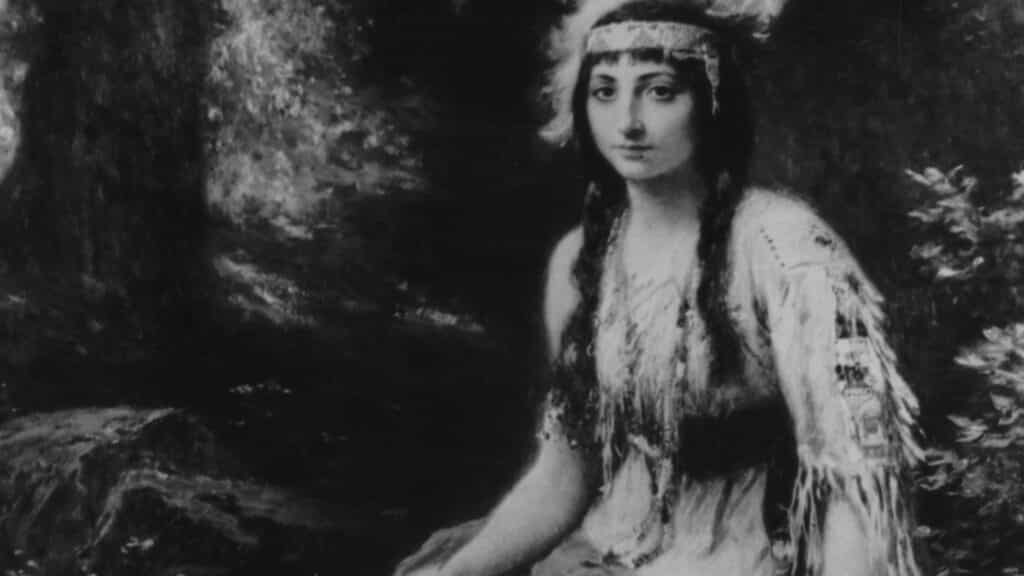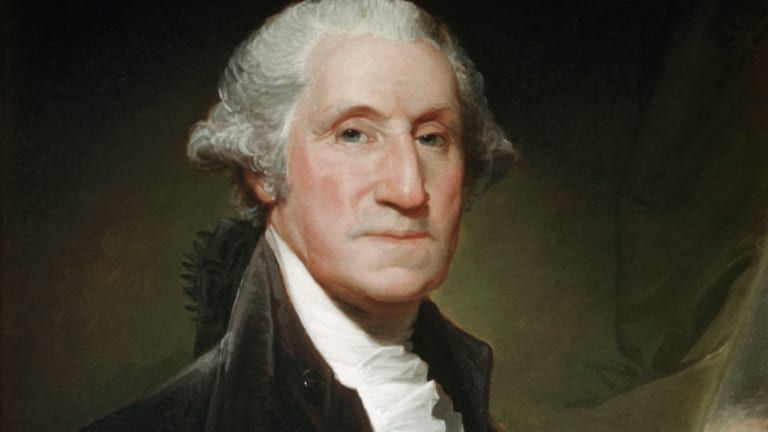Last updated on February 6th, 2023 at 03:18 pm
Few figures from American colonial history are as ubiquitous and perhaps as misunderstood as Pocahontas, the daughter of a Native American chieftain who married an Englishman and ended up in England before passing at an unfortunately young age.
Her life has been immortalized in several works, including two Disney films during the 1990s, which presented largely erroneous and inaccurate portrayals.
Here we relate her true story, the context in which she entered into English society, and her role in the history of early colonial America.

England and North America
However, before looking in-depth at Pocahontas’s life, it is necessary to examine the context in which she encountered the European colonists who would shape her life and future legacy.
English explorers had first made contact with the eastern seaboard of North America in the mid-sixteenth century as they sought to challenge Spain’s primacy in the Americas.
Accordingly, colonial pioneers such as Humphrey Gilbert attempted to establish colonies in the eastern United States during the reign of Elizabeth I (1558–1603), notably Sir Walter Raleigh in North Carolina in the mid-1580s.
However, these proved abortive, and it was not until 1607 that the first permanent English settlement was established on the American mainland. This was in the Chesapeake Sound of Virginia, and the site chosen was named Jamestown after the King of England, James I.
Here, surrounded by the powerful confederacy of the Algonquian led by their chief, the Powhatan, the English eked out a depressing existence for several years, with little more than a hundred or so male settlers often being on the brink of starvation.
Had it not been for the help they received from the local Native Americans and their chief, the Powhatan, they might not have survived.
The Settlers Meet Pochonotas
Pocahontas, also known as Matoaka or Amonute in local dialects, was a Native American princess, the daughter of the Powhatan chief Wahunsonacock.
She was born around 1596 and was thus heading into her teenage years as the Jamestown colony struggled to survive. The name she is most commonly known, Pocahontas, translates roughly into ‘playful one,’ though later when she married into the English society building up in the Chesapeake Sound, she became known as Rebecca Rolfe.
From very early on, Pocahontas played a role in the Algonquian’s interactions with the English at Jamestown, principally with the sometimes leader of the fort, Captain John Smith.
She seems to have acted as an intermediary to implore her father to provide aid to the English colonists during their first years at Jamestown, during which they were often on the point of starvation.
For some reason, colonists opted to spend all their time panning for gold in the James River rather than planting crops.
Later Smith would tell the Queen of England that had it not been for Pocahontas, the colony would never have survived this arduous period.
Conflict Between the Settlers and Tribe
Pocahontas’s involvement with the Jamestown colony temporarily abated when Smith returned to England in 1609, and conflict between the English and the Native Americans broke out.
Indeed in the early 1610s, she was married, albeit while still a teenager, to a local Native American named Kocoum.
It was presumably during her marriage and wherever she had settled that she was captured by an English military band led by Captain Samuel Argall.
The English had grown in numbers during the early 1610s, as extra expeditions to America were funded, largely on the back of the enormous profits that investors in London had realized could be made from cultivating the tobacco in Virginia.
The drug had taken hold, and Europeans were beginning to get a taste for it.
Argall captured Pocahontas in 1613, and the Jamestown colonists leveraged her captivity to force the Powhatan chief into a peace treaty that would last nearly a decade.
The English colonists were beginning to get the upper hand on the Algonquians, who had done so much to help them just years earlier.
Pocahontas marries John Rolfe
While she was in captivity at Jamestown, Pocahontas converted to Christianity. Then, having assimilated to European society, she married one of the colonists who had recently arrived in Virginia to begin cultivating tobacco there, one John Rolfe, a man nearing thirty years of age and a recent widower.
In 1614 she was also baptized as Rebecca. She and Rolfe were married in April 1614. The following year she gave birth to a son, Thomas Rolfe, perhaps the first child born of a union between an English colonist and a Native American, or at least the first such instance for which there is recorded evidence.
The couple now became the source of a propaganda opportunity.
The Virginia Company of London, which had control and oversight of the Jamestown colony, saw in the new Rolfe couple a chance to promote the Virginia colony back in England to those who viewed it as an unsafe place full of allegedly dangerous savages.
Pocahontas could be presented to English society as living proof that the local Native Americans were friendly and, with the proper incentives, could even be made to adopt European’ civility’ and mannerisms.
Accordingly, the Virginia Company now commanded that Pocahontas be brought to England to be presented to high society and London.
As a result, in the summer of 1616, Pocahontas and Rolfe arrived in London with a dozen or so more of the Algonquians, where they were shown around and quite quickly became the talk of London.
The king and queen received her at Whitehall, and the bishop of London hosted a dinner in Pocahontas’s honor at Lambeth Palace just across the River Thames from Westminster.
A portrait of Pocahontas, painted by the Dutch artist Simon de Passe and now quite famous, was produced.
Then in the following weeks, the couple departed from London and were temporarily visited by Captain John Smith, whom Pocahontas had earlier been told was dead but now whom she greeted like a long-lost friend.
Pocahontas’ Death and Legacy
And yet, as infamous as the visit of Pocahontas to England has become, it was to have brutal consequences. Unused to the English climate when severe temperature changes could kill an individual quite easily, Pocahontas became sick in the winter of 1616.
By the time the couple boarded a ship to return to Virginia in the early spring of 1617, she was suffering from either tuberculosis or pneumonia.
Too weak to travel, she was eventually set ashore at Gravesend in Kent, where she died in mid-March 1617.
Her body was subsequently interred in the chancel of St George’s Church. John returned to Virginia, where he remarried but was subsequently killed in the Indian Massacre of 1622.
The Algonquians, realizing belatedly the existential threat the English now posed, attempted to destroy the many colonies established all around the Chesapeake Sound.
Overall, Pocahontas was an extremely significant figure in the early history of colonial America. She contributed substantially to the survival of the Jamestown colony in its earliest and most precarious years.
She after that helped to solidify relations between the Algonquians and the burgeoning colony.
She was also a leading proponent of the idea of Anglicising to accommodate newcomers. In this way, she has become a symbol of early contact between the natives and the newcomers in a land that saw such brutal conflict between the two over the three centuries which followed.
Sources
For previous studies of Pocahontas and the mythmaking surrounding her, see Frances Mossiker, Pocahontas: The Life and Legend (Boston, 1977); Grace Steele Woodward, Pocahontas (Norman, 1969); Frederic W. Gleach, ‘Pocahontas: An Exercise in Mythmaking and Marketing’, in Sergei A. Kan and Pauline Turner Strong (eds), New Perspectives on Native North America: Cultures, Histories, and Representations (Lincoln, 2006), pp. 433–455.
Helen C. Rountree, Pocahontas’s People: The Powhatan Indians of Virginia Through Four Centuries (Norman, 1989); James Horn, A Land as God Made It: Jamestown and the Birth of America (New York, 2005).
Philip L. Barbour, Pocahontas and Her World (Boston, 1970); Frederic W. Gleach, Powhatan’s World and Colonial Virginia (Nebraska, 1997).
On the subsequent impression of Pocahontas, see Robert S. Tilton, Pocahontas: The Evolution of an American Narrative (Cambridge, 1994).

